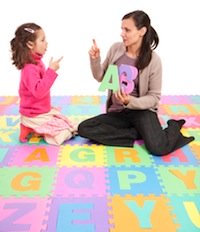How long should daily phonics lesson plans really be? Orton Gillingham phonics is sometimes used as a core curriculum, but not every child needs this type of intensive instruction.
Recently many districts have been adopting Fundations (from Wilson) to use not just as a Tier 2 and 3 intervention, but as their Tier 1 core instruction in phonics. Wilson uses the Orton Gillingham approach to teaching reading.
This approach is very rigorous with 30 minutes every day being spent on just the rules of phonics.
Research shows that students who are taught explicit phonics like this do not outperform students who are taught the rules in a more integrated approach.
Many studies that show gains are actually based on the lowest-performing readers, not the average reader.
As quoted in a white paper by Heinemann research, “Literature-based children were more successful because they made better use of phonics in conjunction with other information and cues,” (Facts on Research on the Teaching of Phonics).
Teaching Phonics Every Day?
Yes, we should be teaching the rules of our language every day. But I am not sure that the achievement of my students is better.
It’s not the program that is the problem. It is the teaching in isolation and the natural give-and-take of other (and I feel – better) methods of teaching and learning.
There simply isn’t enough time in the day to rob Peter to pay Paul.
There are core principles of phonics that must be addressed, however it is done. Language is a pattern and it is based on alphabetic principles and sound/symbol relationships.
- Sounds are isolated in reading and writing (decoding)
- Sounds are blended into words and syllables (encoding)
- Advanced stages of multi-syllabic, morphemic, grammatical, semantic and syntactic structures are taught systematically
The success rate of using this method of daily phonics lesson plans (as opposed to 5-10 minutes daily with other forms of word work, focusing on word families and building bigger words) is reportedly very high.
My data from just my class (admittedly it is not statistically relevant) shows a decrease in RCBM (not good) and a decrease in error rate (good). Draw your own conclusions.
The Orton Gillingham Phonics Approach
There are many activities included in Orton Gillingham phonics lesson plans, but in reality, they cannot all be done every day. They aren’t meant to be, but many are and it is overwhelming at first.
The only one that is done daily is chanting the alphabet letters, blends, digraphs or vowel teams, the associated word and the sound. The other activities include:
- tapping out sounds, blends and digraphs
- using letter tiles to write words
- using syllable frames
- sky writing
- scooping syllables and marking the syllable type
- reviewing trick words
- writing trick words on gel boards
- Word of the Day
- reading passages and scooping phrases for fluency
- dictation of sounds, words and sentences
- learning how to mark different sounds, prefixes, suffixes and root words
All of these are good activities to include occasionally daily phonics lesson plans. Again, it is how much and if you do other types of word work.
Many of my lowest performing students are writing better now, but it hasn’t seemed to make a huge difference in my average to higher-achieving students. I have also seen an increase in phoneme recognition and manipulation, and some phonics sounds games I now play in the classroom wouldn’t have happened without it.
However, I still do not understand why it is necessary to grade on a 7 year old child on how well he can mark a closed syllable exception.
My students are less fluent in prosody and metacognition about reading than other years, as lessons like Readers Theatre and Making Words have been relegated to filler activities due to time. Perhaps that will change as the students who began using this program in kindergarten are moving up.
Final Thoughts:
I am not convinced either by observation or data analysis from AimsWeb and progress monitoring, that this approach produces gains that are of greater significance than other reading fluency activities.
Understand that I certainly do see the value in Fundtions. There is no doubt that it works to help struggling readers who have a reading disability and can provide good support for our line-huggers who are in danger of failing.
My issue though, at the heart of it all, is wondering how this is best for all kids? I’m still not sure.
